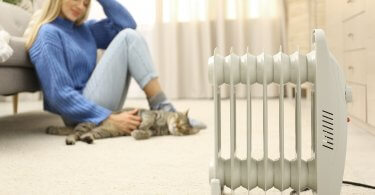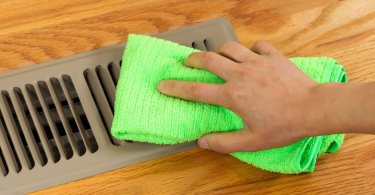You probably know that light bulbs emit heat, but you don’t know how much. So it’s natural if you wonder: does a light bulb make a room hotter? Well, you’ve come to the right place.
We will explain the levels of warmth different light bulb types emit. Read on to find out more about light bulbs and the amount of heat they emit.

Does a Light Bulb Make a Room Hotter?
Yes. But how much hotter a single light bulb makes the room depends on the room size and the bulb in it. Because different light bulbs emit different amounts of heat.
For example, fluorescent bulbs tend to produce the most negligible heat, producing about 25% of the heat an incandescent bulb emits. So it’s not surprising that fluorescent bulbs use only 25% of the electricity incandescent bulbs use.
Therefore, if you want to make your room cooler, or if you want to save on your electricity bills, fluorescent light bulbs are a great option.
Incandescent light bulbs, however, emit more heat. The glass bulbs contain an inert gas. It’s the tiny filament that starts glowing and heating up once the electricity passes through. A thoroughly heated filament can get as hot as 4.000°F!
However, 90-98% of the bulbs’ energy emits as heat. It depends on factors like bulb shape, surrounding airflow, or bulb materials.
For example, 100-watt bulbs have filaments at about 4.600°F and an external temperature of about 140°F to more than 260°F.
That’s why these bulbs are a popular choice for warming specific rooms or areas like:
- Incubators
- Reptile tanks
- Poultry brooding boxes
- Oven toys
- Lava lamps
- Industrial infrared heating
Quartz tube heat lamps are also commonly used in industrial processes like space heating or curing paint.
Can Fluorescent Lights Make a Room Hot?
No. Because this type of light bulb doesn’t inflict any noticeable increase in room temperature.
These bulbs use fluorescence to produce visible light, where electricity excites mercury vapor to produce short wave UV light. It is this UV light that triggers a phosphor coating in the tube and makes it glow.
Only 30% of energy creates heat in the fluorescence method; making these light bulbs energy-efficient and cooler than other light bulbs.
Fluorescence light bulbs emit about 20% of the heat emitted by equivalent incandescent bulbs.
How Much Heat Do Light Bulbs Emit?
According to the law of conservation of energy, there is no creation or destruction of energy. It only transforms from one form to another.
Therefore, when an 80-watt lamp turns on, 80 watts of electricity transform into heat and light energy.
Because the amount of light emitted depends on how much electricity transforms into heat, visible light, or any other energy form like infrared light, some light bulbs tend to emit more light when compared to other light bulbs.
- Incandescent bulbs transform 2.6-5% of energy
- Fluorescent bulbs transform 8.2-22% of energy
- LED bulbs transform 15% of energy
That’s why the bulb type used, and its wattage is the primary determinant of the amount of heat it produces.
The second determinant is the bulb shape, which affects the direction of the projection of heat and light. Because concentrated heat and light in one area produce more heat and brightness than light and warmth spread over large areas.
How To Heat a Room With a Light Bulb
Did you know that you can use science to ascertain how many incandescent light bulbs you need to heat a room?
It depends on the amount of heat needed to change a substance’s temperature by a degree.
For example, a 420 sq. ft. room with a 10 ft ceiling containing 145 kg of air, will need a 40-watt light bulb to burn for one hour to increase the room temperature by just one degree. Think about how many light bulbs you would need to increase the temperature by ten degrees!
Therefore, while it’s scientifically possible to use a light bulb to heat a room, it’s not a practical solution. The amount of money spent to power the light bulb will work out to be much more than it’s worth.
Do LED Lights Make a Room Hotter?
There is so much hype about the efficiency of LED lights, making you wonder if they can heat a room. And the answer to the question is no.
Thanks to its high efficiency, where minimal energy transforms into heat, LED Light bulbs do not increase a room’s temperature.
They are cool when touched and perfect to use for cultivation purposes. They do not overheat or scorch plant leaves even if placed near plants.
LED light bulbs conversely need cool surroundings because too much heat reduces or eliminates their light output. That’s why LED lamps typically come with heat sinks and cooling fans for heat dissipation where minimal heat emits outside.
LED lamps or light bulbs get their name because they use light-emitting diodes (LED) to produce light. These diodes are semiconductor light sources that emit light when an electric current passes through them.
How Much Heat Do LED Light Bulbs Generate?
LED bulbs do generate heat because they consume electricity.
However, they consume much less energy than halogen or incandescent bulbs. They thus generate a fraction of the heat produced by traditional technology bulbs.
LEDs make a better choice for task lighting thanks to their lower heat generation quality. They are thus better used to illuminate heat-sensitive objects like food or artwork that may otherwise get damaged by the produced heat.
The room temperature determines its temperature and the fixture it’s placed in. LED bulbs are more sensitive to heat than incandescent bulbs. That’s why cheap LED bulbs have a warning not to place or use them in fully enclosed fixtures.
There is the risk of the accumulated heat shortening the LED bulb components’ life. It’s thus better to use only LED bulbs rated fully enclosed in these circumstances to avoid voiding the warranty.
Conclusion
If you wonder: does a light bulb make a room hotter? The answer is yes, but only minimally.
Besides, it depends on the light bulb because different light bulbs create varying levels of heat.
However, no matter which light bulb you use, the amount of heat it emits isn’t enough to significantly raise the room temperature.





Leave a Comment